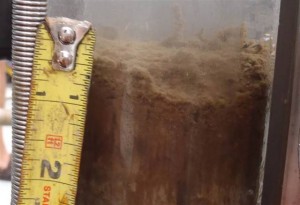http://www.msnbc.msn.com/id/39150640/ns/us_news-environment

Arney Diercks / University of Georgia
A chunk of “oil aggregate snow” is seen in this close-up photograph of fluffy oil residue found on the Gulf’s seafloor.
Fluffy residue found at sites both far off and near wellhead
Special thanks to Richard Charter
Samantha Boye / University of Georgia
A layer of fluffy oil residue sits atop a sediment core taken from a site northeast of the blown-out BP wellhead.
msnbc.com staff and news service reports
updated 9/13/2010 5:44:16 PM ET
Samples taken from the seafloor near BP’s blown-out wellhead indicate miles of murky, oily residue sitting atop hard sediment. Moreover, inside that residue are dead shrimp, zooplankton, worms and other invertebrates.
“I expected to find oil on the sea floor,” Samantha Joye, a University of Georgia marine sciences professor, said Monday morning in a ship-to-shore telephone interview. “I did not expect to find this much. I didn’t expect to find layers two inches thick.”
The scientists aboard the research vessel Oceanus suspect it’s all from the BP spill, but will have to wait until they return to shore this week to confirm it’s the same oil source.
“It has to be a recent event,” Joye said. “There’s still pieces of warm bodies there.”
If it is BP oil, it could undermine the federal government’s estimate that 75 percent of the spill either evaporated, was cleaned up or was consumed by natural microbes.
What the scientists do already know is that the oil is not coming naturally from below the surface.
“What we found today is not a natural seep,” Joye wrote in her blog on Sept. 5 when the first surprise sediment was found.
“The near shore sediments contained grayish muddy clay and a thin layer of orange-brown oil at the surface,” she added. Oil seeping naturally would create an oily stain throughout the sediment cores, but these samples only had oil at the top.
“The oil obviously came from the top (down from the water column) not the bottom (up from a deep reservoir),” Joye wrote.
‘Slime highway’
The researchers also have a name for it: a slime highway.
That’s because they’re confident much of the oil was trapped by mucus coming from microbes that feast on oil in a natural process that helps break up the contaminant. Those microbes are well documented, but not that their mucus was sinking along with oil to the seafloor.
“The organisms that break down oil excrete mucus – copious amounts of mucus,” Joye told National Public Radio. “So it’s kind of like a slime highway from the surface to the bottom. Because eventually the slime gets heavy and it sinks.”
Another factor that could be trapping the oil was the earlier use of chemical dispersants, which might have made the oil so small that it wasn’t buoyant enough to rise.
Joye wrote that the scientists call the substance “‘oil aggregate snow’ – because it settled down the water column to the seafloor just like snow falls from the sky to the ground.”
“If you take a close look at the snow layer, oil aggregates are clearly visible,” she added. “Also visible are pteropod shells (which must have been recently deposited because the shells dissolve rapidly) and remnants of zooplankton (skeletons) and benthic infauna (dead worms and their tubes).”
The researchers took new samples on Monday and Sunday, and hope to take several more, especially closer to the wellhead, before they return.
“It’s weird the stuff we found last night,” Joye said. “Some of it was really dense and thick.”
The samples have come from seafloors at depths ranging from 300 to 4,000 feet deep.
Since the well was capped on July 15, and after some 200 million gallons flowed into the Gulf, there have been signs of resilience on the surface and the shore. Sheens have disappeared, while some marshlands have shoots of green. This seeming recovery is likely a result of massive amounts of chemical dispersants, warm waters and a Gulf that is used to degrading massive amounts of oil, scientists say.